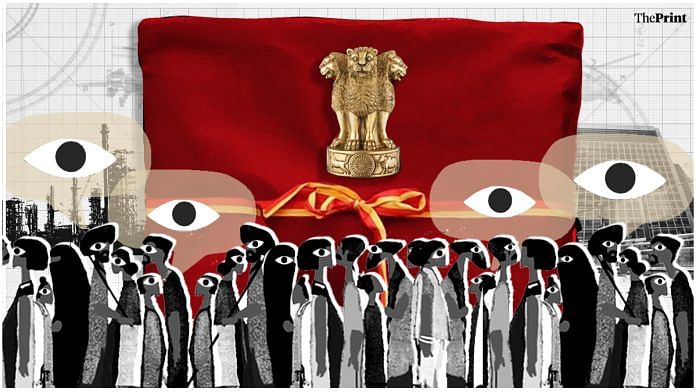
Budget 2021-22 will be focused on alleviating the impact of the pandemic. One set of measures expected is those that give support to households in sections of society where incomes fell sharply during the pandemic.
Finance Minister Nirmala Sitharaman announced some steps in this direction as part of the ‘atmanirbhar’ package during the lockdown, but they were limited by the uncertainty that prevailed in the economy. By now, the condition of the economy as well as the government’s fiscal resources is clear, and better-targeted additional measures can be announced.
The length and depth of the economic impact of the pandemic has been much beyond initial expectations. Measures that directly put money into the accounts of the poor can help lift consumer demand and provide relief to households who have been suffering for one year.
Similarly, tax cuts, whether in income tax or in indirect taxes, can put money in the pockets of households. Not only can this provide relief to those in the middle classes whose family businesses and sources of income have suffered, it can also help push consumer demand, and directly feeds into the mechanisms through which the economy can be put back on the path of recovery.
Emphasis on investment in infrastructure
The second theme expected in the Budget is an emphasis on investment in infrastructure. This is one way for the government to push growth, both in the short run and the long run. The Indian economy contracted by about 7 to 8 per cent in 2020; it is expected to grow at about 11 to 12 per cent next year, taking it to back to the pre-Covid GDP levels in a couple of years.
A development finance institution (DFI) or a development bank that lends to infrastructure projects has been discussed quite a lot lately, and reports suggest the government is keen on this idea. This addresses the question of the maturity mismatch between short-term funds and long-term investment.
In addition, the government is expected to take measures to push investment in manufacturing. Ways to increase employment could include protection to labour-intensive industries that have seen high imports from China. The message that governments support job growth is critical around the world at this time.
Though almost all economists have been critical of rising protectionism for domestic industry, especially when it creates an imbalance between final and intermediate products, the last few years suggest that the government is not shy of protecting domestic industry. Post-Covid, with much greater job loss and stress in the economy, some measures may be expected.
Higher expenditure and lower taxes will increase the government’s borrowing requirement. The fall in taxes and the rise in Covid expenditure are expected to give India a fiscal deficit of about 6 to 7 per cent of GDP in 2020-21. This is expected to be partly offset by the Budget allocations that ministries were not able to spend due to the pandemic.
With the economy reeling under the impact of the pandemic, the government does not need to shy away from a larger fiscal deficit. The deficit is expected to be higher but could stay within single digits to prepare a glide path to fiscal consolidation.
Institutional and legal changes in finance
The Budget is also a time for the finance minister to announce institutional and legal changes, particularly in the financial sector. In 2013, the Financial Sector Legislative Reforms Commission had recommended the setting up of a Financial Redress Agency.
In the present regulatory framework, each regulator has a separate forum that consumers can approach if they have complaints about a financial institution that is regulated by it. For example, for a complaint against a bank, RBI has set up banking ombudsmen.
Often with increasing sophistication and multiple regulatory overlaps in the financial sector products, consumers may not know whom to approach, or not want to go to courts where judicial delays can take a long time. For example, for an insurance product sold by a bank, the customer is confused about whom to approach.
Consumers who do not live in state capitals where the redress mechanism agencies are located may not get justice. A more suitable mechanism would be a single redress agency which all financial sector customers can approach. This agency could work in online mode, accept online submissions, and even do hearings online.
This proposal has been around for a while, but possibly after the pandemic, which saw courts functioning online, it has gained greater acceptability. Reports suggest that the Financial Redress Agency is on the cards in this Budget.
Similarly, with a larger fiscal deficit, institutions such as a Public Debt Management Agency (PDMA) and a Fiscal Council could show the government’s commitment to fiscal discipline in the long run.
Budget 2021-22 will be presented in one of the most difficult times in the economy in recent decades, and the finance minister has a very challenging task in making it. But institutional changes that do not require large expenses and show her government’s commitment to reform can be strong positive signal, and should form an important element of her Budget.
Subscribe to our channels on YouTube & Telegram
Why news media is in crisis & How you can fix it
India needs free, fair, non-hyphenated and questioning journalism even more as it faces multiple crises.
But the news media is in a crisis of its own. There have been brutal layoffs and pay-cuts. The best of journalism is shrinking, yielding to crude prime-time spectacle.
ThePrint has the finest young reporters, columnists and editors working for it. Sustaining journalism of this quality needs smart and thinking people like you to pay for it. Whether you live in India or overseas, you can do it here.